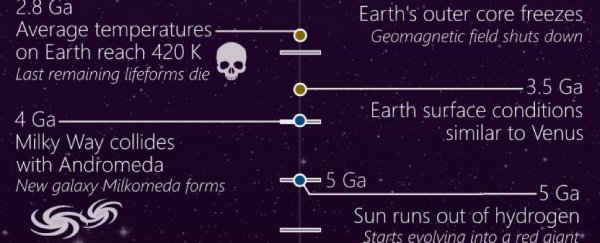If you're the type of person who sometimes wakes up at 3am and lies in bed trying to wrap your tiny mind around the achingly vast Universe and where it's all headed, well, we have something for you (also, same).
This incredible (and incredibly long) infographic from 2015 just keeps going and going and going. Which makes sense, because we're talking about the entire lifespan of the Universe, from the moment of the Big Bang to the 'heat death' of everything we know and love.
Created by Slovak graphic designer Martin Vargic, the Timeline of the Universe covers the past 13.8 billion years of space, and then plots out what's likely to occur in the next 10 billion or so.
He's even separated everything out into things that affect space, Earth, life, and humanity, just so you can really easily see what's going to hit us the hardest in our end of days.
We start out with the beginning of everything - the Big Bang, which gave rise to the Universe 13.8 billion years ago.
The event birthed the oldest known star in the Universe, Methuselah, located about 190.1 light-years away from Earth.
This strange star has caused quite a bit of trouble for astronomers in the past, because estimates had at one point put its age at around 16 billion years - well before the birth of the Universe, which doesn't make sense at all.
It was only in 2013 that scientists were able to reconcile the age of Methuselah with the age of the Universe, using a new method of combining data on its distance, brightness, composition and structure to come up with a significantly younger age for the oldest known star.
"Put all of those ingredients together, and you get an age of 14.5 billion years, with a residual uncertainty that makes the star's age compatible with the age of the Universe," lead researcher Howard Bond from Pennsylvania State University said at the time.
As Mike Wall from Space.com explains, while 14.5 billion is still younger than the estimated birth of the Universe, the uncertainty Bond is referring to allows for plus or minus 800 million years, which means their calculations could put the formation of Methuselah at 13.7 billion years old - just after the Big Bang, although only just.
Fast-forward to 10.4 billion years ago, and the Universe achieves habitability for the first time, and life is finally given a chance to emerge.
Having said that, we're going to have to wait for the 4.2-billion-years-ago mark to actually see any life on Earth at all, but from there, things start to happen very quickly. (The timeline also includes the more conservative estimate of 3.9 billion years ago for when life on Earth first emerges.)
Want to know when the first natural nuclear reactor formed on Earth, or how far back the brightest star in the night sky appeared? Well, I sure hope you like scrolling, because be prepared to do a lot of it to find out.
And once you get the the bottom of the timeline, enjoy, because you'll be steeped in all the gory details of the predicted death of the Universe, including when Saturn's rings will decay into dust, Earth's orbit goes completely out of whack, and the Sun runs out of hydrogen. Good times.
If you love this timeline, head to Vargic's website to download it as an app for Android and iOS.

A version of this article was first published in December 2015.
